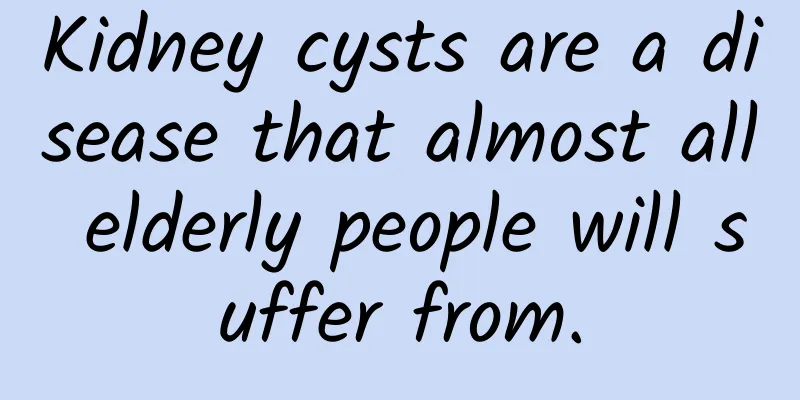Kidney cysts are a disease that almost all elderly people will suffer from.

|
Author: Zuo Li, Chief Physician, Peking University People's Hospital Chairman of Blood Purification Branch of Chinese Society of Research Hospitals Reviewer: Li Mingxi, Chief Physician, Peking Union Medical College Hospital Member of the Medical Science Branch of the Chinese Medical Association Many people find out that they have kidney cysts during physical examinations and become panic-stricken, suspecting that they have a tumor on their kidney and need surgery to remove it. Little do people know that there is a type of kidney cyst that almost all elderly people will suffer from. Let us learn about it. 1. How many types of renal cysts are there? Renal cysts can generally be divided into five types. The first type is simple renal cyst, which is the most common and is caused by kidney degeneration. The incidence rate is very high in the elderly population. Almost all elderly people can be found with one or two renal cysts, or even five or six, and the size of the kidneys will be relatively reduced. The second type is autosomal dominant polycystic kidney disease, which is also more common. When patients are young, they often do not see kidney cysts, but the number of kidney cysts will gradually increase. After the age of 40 or 50, most patients will have multiple cysts in both kidneys. If the patient has three or four cysts in the kidneys at the age of 20 and has a family history of polycystic kidney disease, the diagnosis can basically be made clinically. In addition, autosomal dominant polycystic kidney disease can also be diagnosed genetically, which can detect whether the child is sick at an early stage. The third type is acquired renal cysts, which refers to renal cysts that occur in patients who have been on long-term renal dialysis. Acquired renal cysts usually do not become cancerous, become infected, or have other clinical significance, so usually no intervention is required. The fourth type is medullary cystic disease and medullary sponge kidney, which are relatively rare and may not be diagnosed by ordinary imaging examinations, such as CT or MRI. When medullary sponge kidney is complicated by stones, the arrangement of stones is characteristic and helpful for differential diagnosis; for medullary sponge kidney that has not yet formed stones, intravenous pyelography is helpful for differential diagnosis. The fifth type is renal dysplasia. In renal dysplasia, one small kidney may have a single or multiple cysts. In summary, among the five types of renal cysts, the most common are simple renal cysts and hereditary polycystic kidney disease. 2. What are the dangers of kidney cysts? Different types of renal cysts cause different harms. Simple renal cysts are almost harmless unless they grow in certain special locations, causing urinary tract obstruction or compression of surrounding organs. If the patient is obese and has small kidneys, the burden on the kidneys is greater, and if there is a large cyst in the kidney, it may affect kidney function. In hereditary polycystic kidney disease, patients may have no symptoms or only show elevated blood pressure before developing renal insufficiency. Once renal insufficiency occurs, kidney disease-related symptoms such as anemia, various metabolic disorders, and toxin retention may follow. In the early stages of renal insufficiency, doctors take some measures to correct anemia and metabolic disorders and maintain the patient's quality of life. However, in the later stages of the disease, the cysts will become larger and more numerous, and the part of the kidney that can function will become less and less, so kidney function may gradually be lost until it becomes uremia and requires dialysis treatment. Therefore, a particularly serious complication of polycystic kidney disease is uremia. According to data, among the approximately 800,000 dialysis patients in my country, renal insufficiency caused by polycystic kidney disease accounts for about 2%-3%, equivalent to about 16,000-20,000 people. 3. If a physical examination reveals a kidney cyst, does it require treatment? If a person in his or her 70s or 80s is found to have single or multiple cysts in his or her kidneys during a physical examination, it may be a simple renal cyst caused by kidney aging and generally does not require treatment. Figure 1 Original copyright image, no permission to reprint However, if a teenager is found to have a cyst in the kidney, it is necessary to check whether there is a family history of polycystic kidney disease. Combined with family history and genetic testing, if polycystic kidney disease can be confirmed, the diet should control sodium and protein intake, arrange daily life and work intensity reasonably, and combine necessary drug treatment to reduce the burden on the kidneys and try to slow down the progression of polycystic kidney disease. 4. What should patients with simple renal cysts pay attention to? Patients with simple renal cysts are no different from healthy people and do not need special attention. However, it is recommended to develop good living habits, such as regular and balanced diet, so that the burden on the kidneys will be relatively small. In some special cases, such as low birth weight and small kidneys, the kidney function is weak, and the child becomes obese when growing up, which puts a heavy burden on the kidney. In this case, if a large cyst grows on the kidney and occupies the space of the kidney, the kidney function may be damaged, so obese patients with kidney cysts need to lose weight. Figure 2 Original copyright image, no permission to reprint For patients with hypertension, blood pressure should also be controlled to reduce the burden on the kidneys. These precautions apply not only to patients with simple renal cysts, but to everyone. In addition, some simple renal cysts grow in the renal pelvis, which may block the renal calyx or the passage from the renal pelvis to the ureter. These situations need to be treated. 5. What should patients with polycystic kidney disease pay attention to in terms of diet and exercise? For patients with polycystic kidney disease, the kidneys are occupied by many unhealthy cysts, and there are very few renal units that can perform renal function. Therefore, these patients should strictly control their diet, eat a balanced diet, and minimize the burden on the kidneys. In addition, if the patient has factors that cause kidney damage, such as diabetes and high blood pressure, they must be controlled. It is not recommended for patients with polycystic kidney disease to do strenuous exercise. This is because during strenuous exercise, the metabolic waste of the muscles will increase the burden on the kidneys. At the same time, strenuous activities will lead to increased food intake, increased metabolic waste, and will also increase the burden on the kidneys when excreted from the kidneys. Figure 3 Original copyright image, no permission to reprint In addition, the renal function of patients with polycystic kidney disease will gradually decline, and metabolic complications will occur after it declines to a certain extent. For example, anemia, water retention, calcium and phosphorus metabolism disorders, hyperkalemia, etc. These complications need to be controlled by drugs. Once complications occur, regular reexaminations are required and medications should be adjusted according to changes in the condition. |
<<: The incidence of onychomycosis in diabetic patients is as high as 40%! Pay great attention!
>>: Is cervical spondylotic radiculopathy caused by nerve compression? How to treat it?
Recommend
Will frequent mouth breathing make people ugly?! Can the popular "mouth-closing patch" correct it? Doctors urgently remind us →
Author: Yu Min, attending physician of orthodonti...
Professor Zhi Xiuyi's message lights up the road to fighting cancer, and the 2021 lung cancer patient story documentary will be released soon
Your browser does not support the video tag Colle...
Why do some people look old and some look young? The reason has finally been found
In our lives, some people seem to have "eate...
Can I eat lotus root powder during menstruation?
Female friends cannot eat blood-activating or col...
What are the benefits of drinking wild chrysanthemum tea? Can lotus seed heart and chrysanthemum be drunk together?
There are many ways to drink chrysanthemum tea, a...
The secretion will have a strange smell after the abortion
Abortion is a method that is gradually accepted b...
What to do if a pregnant woman has a sore throat
When a pregnant woman has a sore throat, she shou...
What does it mean when a girl has leucorrhea?
Some girls say that they have leucorrhea every da...
Can I use waterproof stickers on the radiator if it is leaking? What are the ways to repair the radiator if it is leaking?
Radiators are a common way to keep warm in the wi...
Can I eat duck meat during menstruation?
We all know the importance of diet to us. A good ...
Can I eat mayonnaise during my period?
Menstruation for women is a very normal thing. It...
What are the folk remedies for female neurogenic frequent urination?
Under normal circumstances, everyone needs to uri...
Why do women feel stinging pain after urinating?
Women are more susceptible to germs, which is rel...
What are the signs before cancer occurs? Huaxi doctors remind you to detect these 8 changes in your body as early as possible
We often find that many cancer patients are not a...
What happens during normal follicle development?
Usually when women are preparing for pregnancy, t...









